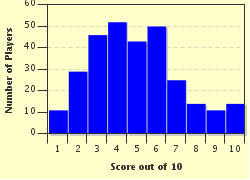Quiz Answer Key and Fun Facts
1. What is the tubelike elongated mouthpart of a butterfly called?
2. Amoebas engulf their food by sticking out finger-like projections called pseudopodia. What is this process called?
3. Name the five processes involved in holozoic nutrition in the correct order of execution.
4. A cow's stomach has four chambers. Name the four chambers in order from mouth to end.
5. What is the phycobiont organism in lichens?
6. Sir Frederick Gowland Hopkins proved that animals can die without ____________ what?
7. Since herbivores only eat vegetable matter, the canines are either absent or not well-developed. So there is a big gap between the incisors and the premolars. What is this gap called?
8. What does a hydra use for ingestion?
9. Insectivorous plants ingest insects with the help of their modified _______ what?
10. Which of the following organisms has the highest metabolic rate?
Source: Author
angikar
This quiz was reviewed by FunTrivia editor
CellarDoor before going online.
Any errors found in FunTrivia content are routinely corrected through our feedback system.

